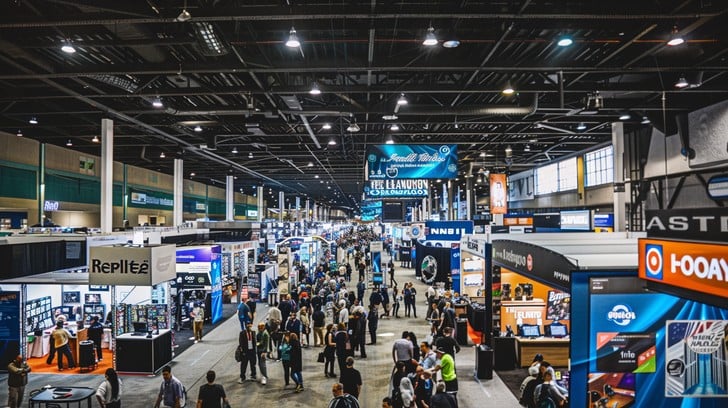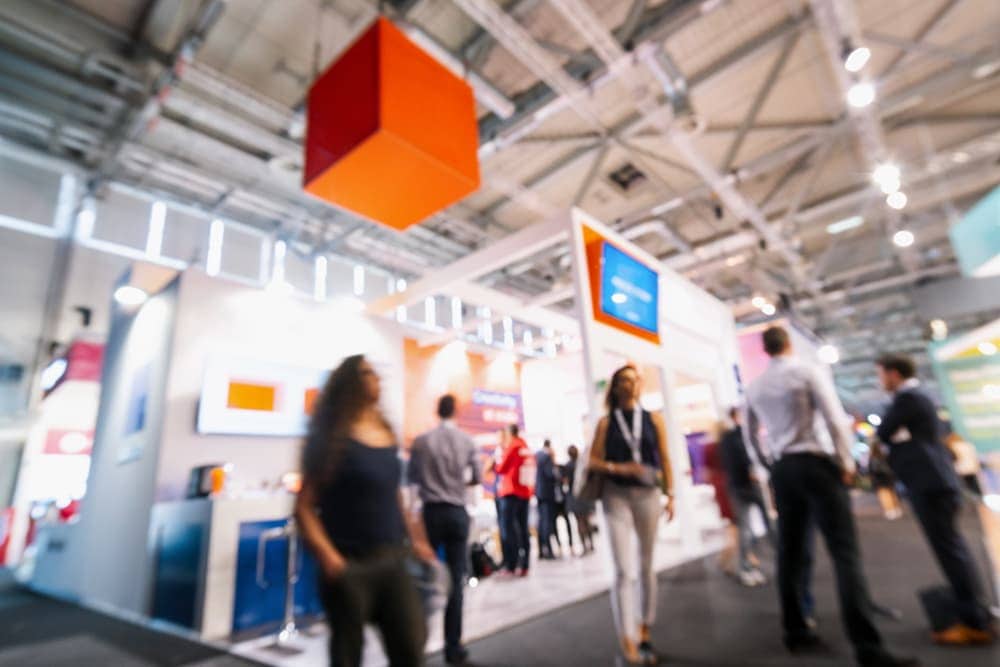This January, exhibit at the meat, poultry, and feed industries’ annual flagship event—The International Production and Processing Expo (IPPE) 2023 show in Atlanta, Georgia. This prestigious show is where food processing and manufacturing thought leaders, business execs, marketing people and more gather to showcase the latest technology, equipment, supplies, and services used in the production and processing of eggs, meat and poultry, and other animal food manufacturing.
It offers a variety of education and interactive exhibits for everyone from feed to fork.
IPPE 2023 is a crucial part of the poultry, animal food and meat industries’ continuing development. During the three-day event, they are offering more than 200 hours of educational programming that covers timely, important information. This expo is a one-stop-shop to discover the efficient ways producers and processors can find solutions and continue operations.
Sponsored by the American Feed Industry Association, North American Meat Institute, and US Poultry & Egg Association, 100 percent of the revenues go back into the industry. These funds are used to provide critical research, education, crisis management assistance, public relations, and regulatory assistance.
If you’re planning on exhibiting at IPPE 2023, you’ll need to know how to make the most of your time there. We’ve put together everything you need to know to make your booth a success.
Looking for a local Atlanta tradeshow booth builder for the upcoming IPPE 2023? Contact Exhibit Experience for your complimentary consultation.
Where and when is the IPPE 2023?
Date: January 24-26, 2023
Location: Atlanta, Georgia
Venue: Georgia World Congress Center
Trade show hours:
Tuesday, January 24: 10:00 am – 5:00 pm
Wednesday, January 25: 9:00 am – 5:00 pm
Thursday, January 26: 9:00 am – 3:00 pm
Who will be at IPPE 2023?
IPPE attendees come from far and wide for the expo. They span a wide range of IPPE industries and hold different roles within their company. Knowing who will be there will help you prepare your exhibition booth for success.
According to the IPPE 2023 Exhibitor Prospectus, attendees include operation and plant managers, purchasing agents, engineers, and researchers from the world’s top feed, meat processing and packing and poultry companies. Attendees typically have one of the following roles at their company:
- 25% C-Level Management
- 22% Sales & Marketing
- 11% Plant/Live Operations
- 8% Engineering/Facility
They’re interested in:
- 35% Animal Health Products
- 32% Packaging Equipment/Products
- 31% Feed Ingredients
- 31% Further Processing Equipment/Products
- 28% Housing and Production Equipment
- 27% Food Ingredients/Raw Materials
- 23% Processing Related Supplies
- 22% Environmental Equipment/Products
- 22% Feed Mill Equipment
- 21% Egg Collection/Grading Equipment
- 21% QA/Food Safety Products
- 16% Slaughter/Evisceration Equipment/Products
- 15% Breeding Stock
- 13% Rendering Equipment/Products
In fact, 75% of all attendees are decision-makers when it comes to purchases and what the company buys.
Regardless of their buying power or job title, it’s important to know what the attendees’ ultimate goals are for the show. In 2022, these were the top six reasons:
- Keep up to date on the latest trends
- Network with others in the industry
- Learn about new products and services
- See the latest technology
- Visit existing suppliers and partners
- Visit new suppliers and partners
Now that you know who will be at the show – and thus, who you’ll need to tailor your sales pitch(es) to – it’s time to learn how to build the best exhibit booth for IPPE 2023. Before you leave for the Georgia World Congress Center, make sure you know what your goals are for your exhibit – that will help you develop your booth and your message for the big day.
How can you stand out at IPPE 2023?
Standing out from this impressive crowd might seem impossible but trust us: we know a few things about building the best exhibit booth!
IPPE show organizers have also prepared an “Exhibiting Helpful Hints” document to help exhibitors navigate the different features available through their website.
Here are a few things you can do to make sure your booth draws a crowd:
- Pick the focal point, and product/service.
-
- Which of your products best fit attendees needs?
- Do you have any new products, services or technologies that offer solutions to the attendee?
- How can you let attendees experience these new things?
- Design a marketing/content campaign around what’s relevant and what’s new.
- Choose the right booth size for your message.
- 10’ x 10’: ideal for a single product or service, or a small line of products. You have room for multiple display cases, 3D graphic wall, custom light display and flooring, and one seating configuration.
- 10 x 20: good solution for those showing a variety of products in the booth. It has 20 feet of graphic back wall, multiple seating configurations for demonstrations and education, in addition to custom light and flooring that come standard with our exhibit rentals.
- 20 x 20: Exhibit Experience usually recommends 20’ x 20’ booths, as these offer demonstration space, enclosures for private viewing, and dozens of other configuration options. However, we understand that many companies have limited budgets this year.
- Decide if you will rent or DIY your booth.
- Experience is key when it comes to standing out at large-scale tradeshows.
- Local tradeshow exhibit rentals for the upcoming IPPE 2023 will help you go that extra mile.
- Design a memorable in-booth experience.
- No matter the size, your booth should tell a seamless brand story.
- Pro Tip: include an interactive experience for your booth visitors.
- Build and train the right team.
- Having the right booth staff is just as important as having the right design.
- Include a mix of people from sales, technical, customer service and management.
- Ditch the hard sell.
- Instead of trying to get sales, focus instead on how your products or services solve a problem.
- Create an itinerary with the networking and social events, educational sessions, and other activities you want to attend. This way you and your team will know when you’ll be at the booth.
- Follow up. Use the travel time home to send follow-up emails to thank visitors for their time and remind them about your company.
How much space will you have?
The IPPE offers exhibitors a minimum 10’ x 10’ booth with 8’ high backwall and 3’ high sidewall drapes (both in black). Exhibitors are responsible for filling that space (and carpeting it) for the show. Larger configurations are available at IPPE. In fact, two-level island stands are also possible.
If you’re interested in these sizes and configurations, ask us about these options during the complimentary consultation.
Curious about how much booths cost? Read our Costs of Exhibiting After 2021 article.
Need a reliable booth builder for the IPPE 2023?
Exhibit Experience is the preferred trade show booth builder for the IPPE 2023 show. We produce state-of-the-art exhibits within a variety of budgets. From custom to pre-certified exhibits, we’ll have the booth you need to show your company the right way.
We will:
- Design and build your exhibit to the right specs
- Provide 24-hour support throughout the trade show.
- Set up and take down your booth
The Exhibit Experience team has over two decades of experience delivering custom exhibits and custom modular exhibits that see instant results. Our exhibit management services are all-inclusive, from design to delivery. We will deliver your exhibit on time, on budget, and following all safety protocols.
If you are looking for an IPPE 2023 trade show booth builder, look no further than Exhibit Experience! Contact us today for a complimentary consultation.
Dimensional Strategy: Selecting the Optimal Booth Size
Exhibit Experience offers customized solutions across a comprehensive range of booth dimensions to align with your specific marketing objectives, budgetary parameters, and venue requirements:
- 10′ × 10′ (100 sq ft): Entry-level presence with focused messaging
- 10′ × 20′ (200 sq ft): Enhanced linear exposure with expanded demonstration capabilities
- 20′ × 20′ (400 sq ft): Premium presence with significant impact potential in peninsula or island configurations
- 20′ × 30′ (600 sq ft): Extended engagement space allowing for multiple activity zones
- 30′ × 30′ (900 sq ft): Substantial presence enabling comprehensive brand storytelling
- 30′ × 40′ (1,200 sq ft): Commanding footprint supporting complex multi-functional exhibits
Each dimensional increment represents not simply additional square footage, but expanded strategic possibilities for engagement, demonstration, and differentiation within the competitive exhibition landscape.
Navigating Regulatory Parameters: Essential Compliance Guidelines
Successful exhibition strategy requires not only creative vision but meticulous adherence to industry regulations and venue-specific requirements. The following regulatory considerations represent critical compliance factors for all exhibitors:
1. Vertical Space Utilization & Height Restrictions
Linear/Inline Booth Regulations:
- Maximum 8′ (2.5m) height allowance at back wall
- Graduated height restrictions approaching the aisle
- 4′ (1.2m) height limitation within 5′ (1.5m) of aisle frontage
- Strict enforcement to prevent sight line obstruction
Perimeter Booth Regulations:
- Enhanced rear wall height allowance up to 12′ (3.7m)
- Maintained 4′ (1.2m) height limitation within 5′ (1.5m) of aisle
- Specific venue guidelines may apply to projection heights
Peninsula Booth Regulations:
- Height allowances typically between 16′-20′ (4.9m-6.1m)
- Potential restrictions within 5′ (1.5m) of adjoining exhibits
- Back wall finishing requirements when visible to neighboring exhibits
- Prohibition of competitor-facing logos on reverse surfaces
Split Island Booth Regulations:
- Height allowances comparable to peninsula booths (typically 16′-20′)
- Shared back wall must be finished on both sides with neutral coloration
- Branding must not intrude onto neighboring exhibitor’s space
- Typically requires coordinated approval of structural elements along shared boundary
- Specialized rules may govern sound projection toward the shared boundary
Island Booth Regulations:
- Maximum height utilization (typically 16′-20′ depending on venue)
- Ability to incorporate suspended elements with proper approvals
- Rigorous engineering certification requirements for multi-level structures
- Line-of-sight considerations for suspended signage
2. ADA Compliance Requirements: Creating Accessible Exhibits
The Americans with Disabilities Act establishes non-negotiable standards for exhibit accessibility:
- Universal Experience Mandate: Exhibits must provide substantially equivalent experiences to all attendees regardless of physical ability
- Pathway Requirements: Minimum 36″ (91cm) clear path throughout exhibit areas
- Elevation Transitions: Any raised platform exceeding ½” requires ADA-compliant ramping with specific slope ratios (1:12 maximum)
- Interactive Element Placement: Engagement features must be accessible from wheelchair height (maximum 48″ reach range)
- Audiovisual Considerations: Presentations should incorporate captioning when feasible
- Service Animal Accommodation: Sufficient clearance for service animals throughout exhibit spaces
Non-compliance with ADA requirements carries significant consequences, including potential removal from the event, financial penalties, and reputational damage. Professional exhibit partners provide invaluable guidance in designing fully compliant spaces that elegantly accommodate all visitors.
3. Spatial Boundary Enforcement
Exhibit footprints are contractually defined with zero tolerance for encroachment:
- All exhibit elements including product displays, literature racks, and furniture must remain completely within the defined booth space
- Projection of images, lighting effects, or sound beyond booth boundaries is strictly prohibited
- Suspended elements must be positioned within the vertical projection of the booth footprint
- Unauthorized marketing activities outside designated booth space (“guerrilla marketing”) may result in penalty fees or expulsion
4. Sight Line Preservation Protocol
Exhibition environments function through carefully calibrated visual accessibility:
- Structures exceeding 4′ (1.2m) in height are prohibited within the front 5′ (1.5m) of standard and perimeter booths
- Peninsula exhibits must consider neighbor visibility when positioning tall elements
- Transparent or semi-transparent materials are recommended for necessary partitions in high-traffic visibility zones
- Interactive displays must be positioned to prevent aisle congestion
5. Illumination & Electrical Safety Standards
Lighting design must balance impact with consideration for the overall exhibition environment:
- Directional lighting must be focused inward toward the exhibitor’s own space
- Strobe effects, flashing sequences, and moving lights typically require special permission
- Lighting intensity must avoid creating uncomfortable glare for attendees or neighboring exhibitors
- All electrical connections must comply with local building codes and certification requirements
- Cable management must eliminate tripping hazards through appropriate concealment or floor covering
- Power load calculations must be submitted in advance for verification against venue capacity
6. Intellectual Property & Audio Licensing Requirements
Content presentation within exhibits carries specific legal obligations:
- Music, video content, and other copyrighted materials require appropriate licensing documentation
- Performance rights organizations (ASCAP, BMI, SESAC) may actively monitor compliance at major events
- Volume levels for audio content are subject to specific decibel limitations
- Scheduled presentations must adhere to show management guidelines regarding frequency and duration
- Alternative solutions include royalty-free music libraries and blanket license arrangements available through show management
Location-Specific Compliance: Navigating Regional Requirements
Major exhibition venues maintain distinct regulatory frameworks that may supplement or modify industry standards:
- Las Vegas Convention Center: Stringent fire safety requirements with specific material certification needs and unique rules for multi-level structures
- Orange County Convention Center (Orlando): Specialized electrical codes and detailed rigging regulations for suspended elements
- McCormick Place (Chicago): Union labor requirements and specific loading dock procedures that impact installation timelines
- Javits Center (New York): Enhanced security protocols and specific weight-bearing limitations for exhibit components
- International Venues: Substantially different regulatory approaches requiring specialized knowledge of local standards and certification requirements
Professional exhibit partners with experience across multiple jurisdictions provide invaluable guidance in navigating these complex and constantly evolving regulatory landscapes.
Exhibit Experience: Your Partner in Exhibition Excellence
Creating impactful, compliant trade show environments requires specialized expertise that transcends standard marketing capabilities. Exhibit Experience delivers turnkey solutions characterized by:
Comprehensive Design Integration Our design process incorporates regulatory compliance from conceptual development through final execution, eliminating costly modifications and ensuring seamless approval processes.
In-House Production Capabilities Vertical integration of manufacturing and graphic production provides unparalleled quality control while accommodating compressed timelines:
- Direct oversight of fabrication processes
- Elimination of third-party communication inefficiencies
- Rapid response capability for last-minute adjustments
- Proprietary quality control protocols exceeding industry standards
Dedicated Installation Teams Unlike providers relying on temporary labor, our specialized installation professionals:
- Maintain intimate familiarity with our proprietary systems
- Execute with precision honed through repeated collaboration
- Provide continuity from project to project
- Deliver exceptional problem-solving capabilities on-site
Strategic Geographical Positioning Our operational presence in primary exhibition hubs delivers substantial logistical advantages:
- Reduced shipping costs and transit risks
- Enhanced scheduling flexibility
- Rapid response capability for unexpected challenges
- Established relationships with venue management teams
Conclusion: Elevating Your Exhibition Strategy
Strategic trade show participation represents one of the most significant marketing investments many organizations make annually. Maximizing the return on this investment demands not just creative excellence, but sophisticated understanding of the technical, regulatory, and logistical factors that determine success.
By partnering with Exhibit Experience, you gain access to specialized expertise that transforms these complex considerations into seamless execution—allowing your team to focus on what matters most: meaningful engagement with your target audience and the advancement of your strategic objectives.
Ready to elevate your exhibition strategy? Contact Exhibit Experience today for a consultative assessment of your trade show program and discover how our integrated approach can enhance your brand presence while optimizing your marketing investment.











